Świlcza
Świlcza, Rzeszów district, a village in south-eastern Poland, on the western periphery of Rzeszów (Fig. 1). In 1970 a local farmer, Leopold Skupień, was widening the road to his field when he came across a large lump of amber. He reported this find to the staff of the regional museum in Rzeszów (Muzeum Okręgowe w Rzeszowie). Several seasons of archaeological excavation made with some interruption in 1970-1982 resulted in uncovering a →Przeworsk Culture settlement (site no. 3), one of very few settlements in Poland dated reliably to the →Migration Period .
The settlement lies on a high eastern loess bank of a stream; resting at a depth of more than 2 m below the modern ground level the culture deposit retained much material in excellent condition – such as the timber logs and planks of the walls of huts. Nine features were unearthed, among them, two huts and two amber workshops, in what presumably was the production area of a larger settlement (Fig. 1).
Hut no. 1 (4.6 x 5.3 m) is a partly sunken structure with a hearth in its floor. On its south side is an annex (2.0 x 3.2 m) which in 1976 was the site of discovery of a hoard of gold and silver ornaments and coins deposited in a leather pouch.
Hut no. 2 (5.2 x 7.0 m) is a partly sunken structure with a central hearth. On its NE side was an annex. The large quantity of decomposed wood discovered to the north of the hut was interpreted as the remains of timber walls.
Amber workshop no.1 (surviving fragment – 4.4 x 6.0 m) a feature of approximately trapezoidal plan. Finds recovered from the workshop and its surrounding area included 232 complete and 43 fragmented amber beads as well as a lump of amber weighing 305 g.
Amber workshop no. 2 (4.0 x 4.4 m) a feature of approximately rectangular plan. Finds recovered from the workshop included 156 complete and 10 fragmented amber beads as well as a fragment of an amber lump.
No hearths of remains of timber walls were discovered in the workshops.
Of 388 complete and 53 fragmented beads discovered at Świlcza (see Figs. 2 and 3) only two were turned on a lathe, the rest were made by hand. The working of amber is confirmed by the discovery of four sharpened bone objects, a hone of grey sandstone, a grindstone and flint tools. Analysis of the amber confirmed its Baltic provenance (succinite).
The hoard discovered in 1976 (see Figs. 4, 5 and 6) included two gilded silver brooches, two silver brooches, a gold pendant-earring, a bronze pendant, a silver bar bracelet (octagonal of section), a glass bead, bone and flint tools and 10 denarii from the 2nd century AD. Three brooches are type Wiesbaden, their ornamentation in →Sösdala-Untersiebenbrunn Style, known e.g., from the →Świelino hoard in Pomerania dating the hoard to the close of the first half of the 5th c. AD, a chronology confirmed by dendrochronology dates secured from the timber of the hut no. 1 (433 +/- 10 years).
The settlement at Ś. was in use in the period late 4th - mid-5th century and may have been abandoned due to external threat (quite possibly – →Huns ) as suggested by the unclaimed hoard from hut no. 1.
MW
Literature: A. Gruszczyńska, Badania na osadzie z V w. n.e. w Świlczy, woj. podkarpackie w latach 1977, 1981-1982, Materiały i Sprawozdania Rzeszowskiego Ośrodka Archeologicznego, 20, 1999, p. 165-187; A. Gruszczyńska, Osada z V wieku w Świlczy na tle osadnictwa w regionie rzeszowskim, [in:] S. Czopek, A. Kokowski (eds.), Na granicach antycznego świata. Sytuacja kulturowa w południowo-wschodniej Polsce i regionach sąsiednich w młodszym okresie przedrzymskim i okresie rzymskim, Rzeszów 1999, p. 285-302; K. Godłowski, Ziemie polskie w okresie wędrówek ludów, [in:] K. Godłowski, Pierwotne siedziby Słowian, M. Parczewski (ed.), Kraków, 2000, p. 309-344; M. Mączyńska, Das Ende der Przeworsk-Kultur, [in:] Die Vandalen. Die Könige. Die Eliten. Die Krieger. Die Handwerkert, Holzminden 2003, p. 185-201; A. Bursche, J. Kowalski (ed.), Barbarzyńskie Tsunami - Okres Wędrówek Ludów w dorzeczu Odry i Wisły, Warszawa-Szczecin 2017.
-
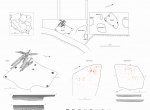 full resolution
full resolution
Fig. 1. Świlcza, Świlcza commune, Rzeszów district, site 3. Location, plan of settlement and plan of hut no. 1 and amber workshops 1 and 2; according to A. Gruszczyńska (1999a; 1999b) redrawn by J. Ożóg (simplified). 1 – brown-black earth with substantial
-
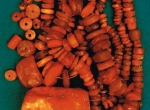 full resolution
full resolution
Fig. 2. Świlcza, Świlcza commune, Rzeszów district, site 3. Lumps of amber and amber beads; Photo. S. Czopek (by permission of the district museum in Rzeszów).
-
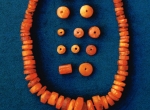 full resolution
full resolution
Fig. 3. Świlcza, Świlcza commune, Rzeszów district, site 3. Amber beads; Photo. S. Czopek (by permission of the district museum in Rzeszów).
-
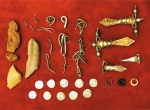 full resolution
full resolution
Fig. 4. Świlcza, Świlcza commune, Rzeszów district, site 3. Hoard of ornaments and coins (annex of hut no. 1) – general view; Photo. S. Czopek (by permission of the district museum in Rzeszów).
-
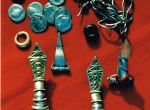 full resolution
full resolution
Fig. 5. Świlcza, Świlcza commune, Rzeszów district, site 3. Hoard of ornaments and coins (annex of hut no. 1) – general view; Photo. S. Czopek (by permission of the district museum in Rzeszów).
-
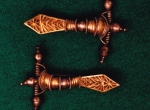 full resolution
full resolution
Fig. 6. Świlcza, Świlcza commune, Rzeszów district, site 3. Hoard of ornaments and coins (annex of hut no. 1) – gilded silver brooches (type Wiesbaden); Photo. S. Czopek (by permission of the district museum in Rzeszów).
-
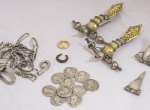 full resolution
full resolution
Fig. 7. Hoard found at the settlement at Świlcza, Rzeszów District, around 430 AD; collection of the Regional Museum in Rzeszów (phot. by P. Nycz)


